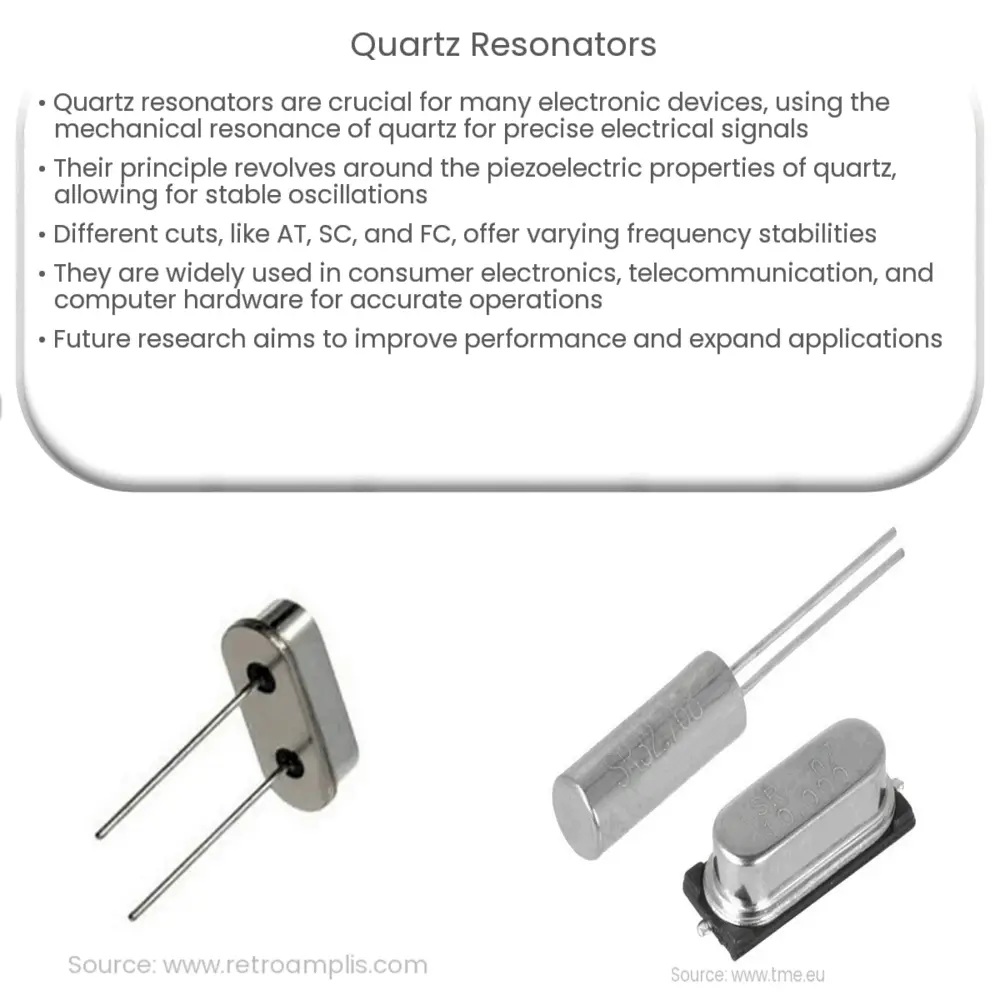Explore the world of quartz resonators, their principles, types, applications, manufacturing process, and their role in modern electronics.

Introduction to Quartz Resonators
Quartz resonators are an integral part of many electronic devices we use in our daily lives. In essence, these are devices that use the mechanical resonance of a vibrating crystal of piezoelectric material, such as quartz, to create an electrical signal with a very precise frequency. This frequency is commonly used to keep track of time in watches and clocks, to provide a stable clock signal for digital integrated circuits, and to stabilize frequencies for radio transmitters and receivers.
The Principle of Quartz Resonators
The principle behind quartz resonators lies in the piezoelectric properties of quartz. When an alternating voltage is applied across a quartz crystal, it causes the crystal to oscillate at a constant and precise frequency. This frequency is dependent on the cut and size of the crystal. This physical property of quartz is used to create an accurate and stable oscillatory circuit.
Types of Quartz Resonators
- AT Cut Quartz Resonator: AT cut is the most common type of quartz resonator. It is designed to minimize the frequency variation due to temperature changes, making it ideal for a wide range of applications.
- SC Cut Quartz Resonator: SC cut resonators provide improved temperature stability compared to AT cut resonators. They are primarily used in precision oscillators.
- FC Cut Quartz Resonator: FC cut is a doubly rotated cut designed to offer superior frequency stability over temperature.
Applications of Quartz Resonators
Quartz resonators have a wide variety of applications in various fields. Let’s discuss some of them in detail:
- Consumer Electronics: Quartz resonators are used in devices such as wristwatches, clocks, and radios to provide a stable time base.
- Telecommunication: In the telecommunication industry, quartz resonators help in frequency control and signal generation.
- Computer Hardware: They also provide the clock signal that synchronizes operations in digital circuits, such as microprocessors and memory chips.
The role of quartz resonators in these applications is fundamental as it ensures the accurate operation of these devices.
Manufacturing Process
Manufacturing quartz resonators is a highly sophisticated process. It begins with the mining of raw quartz, which is then processed to remove impurities. After the quartz is purified, it is sliced into thin wafers. The thickness of these wafers is carefully controlled to achieve the desired resonant frequency. Once the wafers are cut, they are polished and mounted into a suitable housing.
Advantages of Quartz Resonators
Quartz resonators are renowned for their accuracy and reliability. Their primary advantage lies in their stability over a wide range of temperatures and their high Q-factor, which refers to the energy stored versus the energy lost in each oscillation. Furthermore, quartz is readily available, making these resonators cost-effective.
Challenges and Limitations
Despite their many benefits, quartz resonators are not without their challenges. They are sensitive to physical stresses, including pressure, acceleration, and temperature, which can affect their performance. Moreover, they have limitations on their frequency range, primarily due to the physical size of the crystal. Overcoming these challenges is a key focus of ongoing research in the field.
Future Prospects
The future of quartz resonators is looking bright with potential advancements in technology. There is active research focused on improving the performance and reducing the size of quartz resonators. This could further extend their applications in emerging fields such as IoT (Internet of Things), autonomous vehicles, and high-frequency communication systems.
Conclusion
In conclusion, quartz resonators play a critical role in the operation of a plethora of electronic devices, ensuring accuracy and stability. They leverage the unique piezoelectric properties of quartz to produce a consistent frequency output. While there are challenges associated with their use, ongoing research and development promise potential improvements and new applications. As technology continues to advance, the importance of quartz resonators in modern electronics will undoubtedly continue to grow.

